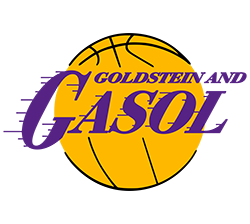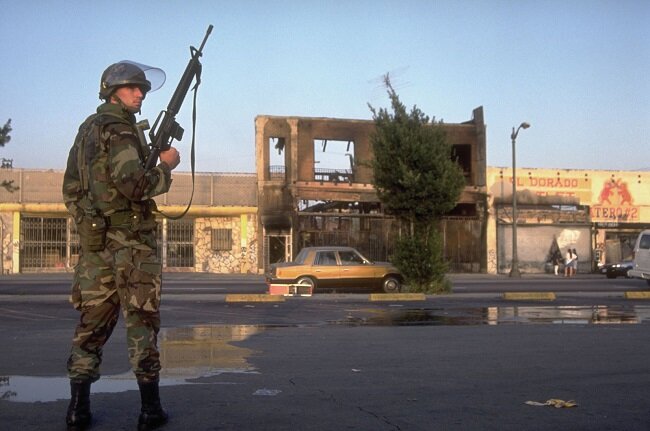Game 61: Tom Bradley - Mrs. Tom Bradley's Chili
On March 3rd, 1991, Rodney King became America’s first unwitting viral video star. After a night of drinking, King was spotted drunk driving on the 210 freeway by the husband and wife CHP duo of Tim and Melanie Singer. Following an eight mile chase, LAPD officers cornered King and tasered him, then proceeded to beat, club, and kick him for several minutes. Much is made of the amateur videotape that captured this police brutality, evidence that finally proved to the nation what L.A.’s black community said they had suffered under the paramilitaristic and corrupt police department that claimed to protect and serve America’s 2nd biggest city.
But let’s not forget that when those five police officers -- Laurence Powell, Timothy Wind, Theodore Briseno, Rolando Solano, and their superior Sergeant Stacey Koon -- nearly beat King to death, they weren’t doing it in hiding, behind some skeezy back alley or industrial parking lot. They did it while a police helicopter shined a blistering light on their actions. Other cops formed a circle and casually watched a defenseless, moaning, bloodied King take baton strikes to his stomach. Civilian vehicles slowed down to watch, but even then the cops didn’t ease up on their beating. This was normal. This was the LAPD under Chief Daryl Gates. And it was the LAPD that Mayor Tom Bradley had served in for two decades.
Despite their mutual blue heritage, Gates and Bradley also shared a distrust of each other that lasted for the majority of Bradley’s record twenty years as L.A.’s first black mayor. And it was March 3rd, 1991’s shining light on the brutal reality of the LAPD that led to their simultaneous downfall on April 29th, 1992
------------------
Before he was L.A.’s longest-serving and first black mayor, before he was L.A.’s first black city councilman, Thomas J. Bradley was a cop. When he joined the LAPD, he was one of only 100 black officers in a corrupt and racist organization that numbered 4,000. Racist and corrupt shouldn’t surprise anyone with even passing knowledge of L.A.’s police, but what made that LAPD different from the LAPD of the 1960s or 1990s was that it was inefficient. The LAPD was controlled by the warring forces of City Hall and gangsters, something that reform-minded officer William H. Parker sought to change. As he rose to chief of police, Parker instituted protections for the LAPD, from rank-and-file officers all the way up to chief, giving the LAPD its own power and shielding it from powerful mayors and mobsters. He also turned the LAPD into a paramilitary strike force that didn’t wait for crime to happen like in other major cities. Instead, LAPD officers patrolled the streets of certain neighborhoods (read: black and brown) to shake down certain people that they viewed as high risk.
While Bradley was a cop, he was limited to the neighborhoods he could patrol and he wasn’t allowed to ride in a squad car with a white partner. And even though he made attempts at true integration of the LAPD, Parker was an abject racist who called Watts rioters “monkeys in a zoo” and said Latino crime was a result of people being descended from the “wild tribes” of Mexico. During his time as chief of police, a young officer named Daryl Gates became his personal driver. And during all those long drives around the Southland, the protege clearly took after his mentor.
A year into his second term, Mayor Bradley had his opportunity to influence the selection of the next chief of police. The one person he did not want was Daryl Gates. According to his autobiography, Parker had told a young Gates that Bradley was a “traitor” to the department. Never mind that Gates was once a cop-punching teen in his youth and Bradley served 20 years in a department that viewed him as a second-class citizen. But Bradley also viewed Gates with contempt, seeing the co-inventor of SWAT Teams as someone who would continue the fear-based policing of Parker. But Gates’ civil service scores were too high for him not to be voted in by the commission in charge of hiring (and firing) police chiefs. So in 1978, Gates accomplished his tactical rise to power and was sworn in as Los Angeles’ newest chief of police.
Flash forward to April 1991, a month after the Rodney King beating led off the nightly news for consecutive weeks. In the decade prior, Bradley had made two unsuccessful runs for governor and was losing popularity, despite having won an unprecedented 5th term. And while crime flourished in 1980s L.A., violence and corruption also became so synonymous within the LAPD that even a white kid from suburban Ohio knew what daily life was like in South Central, as long as he had a record player and N.W.A.’s debut album. With Gates reportedly telling advisers to “go pound sand” after they recommend that he strongly condemn the officers who beat King, Bradley called on him to resign. “I simply will not stand by as our city is being torn apart,” he said. “The LAPD`s reputation cannot be restored as long as Daryl Gates is at the center of the storm of protest.”
As disengaged as he was by 1991, Gates refused to go down without a fight. Shortly after Bradley’s speech, the police commission put Gates on a 60 day administrative leave. He sued the commission, who agreed to rescind their order if he dropped his lawsuit. Bradley and Gates wouldn’t talk to each other for another 13 months, not until the city went up in flames. In between that time, a civilian panel was opened to investigate the LAPD, resulting in proposition called Measure F being put on the city’s 1993 ballot. Measure F sought to rescind most of the protection against City Hall and civilian commissions that Parker fought to win almost a half century earlier. It would term limit the police chief to 10 years. It would add civilians to police misconduct panels. And most importantly, the mayor would retake his power -- with approval of the city council -- to name the police chief.
The Rodney King verdict was announced shortly after 3pm in April 29th, 1992. Bradley, who was criticized during his long mayorship for his lack of emotion and nicknamed the Sphinx for his stoicism, harshly criticized the jury. He told the city’s black community in a speech not to erupt, but had privately talked with the LAPD about their plan if full-scale civil disorder broke out. He and Gates were still not on speaking terms, but Gates’ underlings assured the mayor that they had a plan. They didn’t. Even the most basic move -- closing major intersections to traffic -- wasn’t ordered. When the police responded to calls in the first hour after the verdict, the cops realized they were outnumbered by angry Angelenos, many of them armed, looking for revenge. So the LAPD pulled out of the neighborhoods they terrorized for years and waited for word from their defiant chief about how to proceed.
Gates was nowhere near the epicenter of the riot. He wasn’t at a command post or LAPD headquarters either. He was in Brentwood, attending a fundraiser to help defeat Measure F. Days later, he would tell reporters that he “had a commitment” and that it wasn’t a “full-scale riot” yet when he was raising money to protect his mentor’s life’s work. By day 2, the rioting had spread north to Koreatown and Hollywood, southwest to Inglewood and Hawthorne, and southeast to Compton and Long Beach. The LAPD were paralyzed but Gates’ ego wouldn’t allow him to call for outside help to fix decade’s worth of contempt from Angelenos towards the LAPD. Finally, Bradley called Governor Pete Wilson’s office to request the National Guard and shortly after that, they both asked for federal troops. On day 4, President George H.W. Bush sent in 2,000 soldiers and 1,000 Marines to quell a rebellion in the country’s 2nd largest city. They joined 10,000 National Guardsmen. The heavy-handed military tactics instituted by William H. Parker and brutally employed by Daryl Gates had backfired so badly in Los Angeles that the city needed the actual military to end a citizen rebellion.
In June, Gates finally resigned. There was no going back from the events of April-May 1992. He left the LAPD with his typical bluster and ego, apologizing for nothing and taking every opportunity to attack his enemies in City Hall, on the police commission, in the press, and even those within the LAPD who he felt betrayed him. That same month, Angelenos passed Measure F with a large 2-1 margin, a margin that was much closer before Gates’ disastrous 13 months between the Rodney King beating and the Rodney King riots. Gates’ arrogance had ensured that none of his predecessors would enjoy the absolute power he once wielded.
That wasn’t the only election affected by the riots. Besieged by the media, city leaders, and Angelenos for his response to the riots, Bradley announced that he was reversing his decision to run for a 6th term. With worsening crime, traffic, and pollution and a slowing economy, it was likely that he would have faced his toughest election, even without the riot. But nobody could’ve predicted what happened in 1993: Richard Riordan, a lawyer who had never run for office, wiped out Bradley’s liberal coalition to become L.A.’s first Republican mayor in 36 years. He won by coalescing the anger of white voters, mostly from neighborhoods who safely watched the riot from their TVs. Bradley and Gates both lost the beloved institutions that they molded in their own image, but Gates, who was willing to stand by and let the city he had pledged to protect burn to make a point, won their personal feud.
————————
Mrs. Tom Bradley’s Chili
2 pounds freshly ground beef
1 ½ teaspoons salt
4-6 tablespoons chili powder
1 bay leaf
1 tablespoon ground cumin
1 clove garlic
1 6-ounce can tomato sauce
2 20-ounce cans of kidney beans, drained
3 tablespoons oil
½ teaspoon pepper
2 cloves
¼ teaspoon paprika
2 medium onions
2 green peppers
2 cans whole tomatoes
In cooking oil, saute finely chopped onions and green peppers. Add ground beef; brown, mixing thoroughly so that meat is crumbled. Add some of the chili powder while these ingredients are browning.
In large pot, simmer the tomatoes and spices. When meat is thoroughly browned and crumbled, add meat, onions, and green peppers to pot. Add canned beans. Serve hot bowls of chili with fresh green salad and garlic toast.
“Don’t forget to supply a bowl of freshly chopped onions for those who wish to sprinkle it on top of the chili.”
I’ve been replacing ground beef and real sausage (ground up hog anuses) with Beyond beef and sausage for all my home cooked meals for about a year now. And while the scientists at Beyond Meat have found a way to make a beef patty that tastes like a burger when properly season and seared, I’m still not convinced it’s hit that mark for dishes that need to be cooked on low heat for hours to bring out all the flavors. With soups, stews, and chili -- especially chili -- I’ve yet to make an A+ meal. B+ at best.
That was the case with this chili. The chili didn’t mention the size of the whole tomato cans, so I went with the biggest ones available to be safe. The chili ended up being a little too tomatoey, but not meal-ruining. Unfortunately, the Beyond Meat just didn’t do the rest of the chili justice. That’s my fault, Mrs. Bradley. My doctor said to cut out as much animal protein as possible to prevent further kidney stones. It’s his fault every other bite of your otherwise delicious chili had a chunk of flavorless meat-like chunks.
















